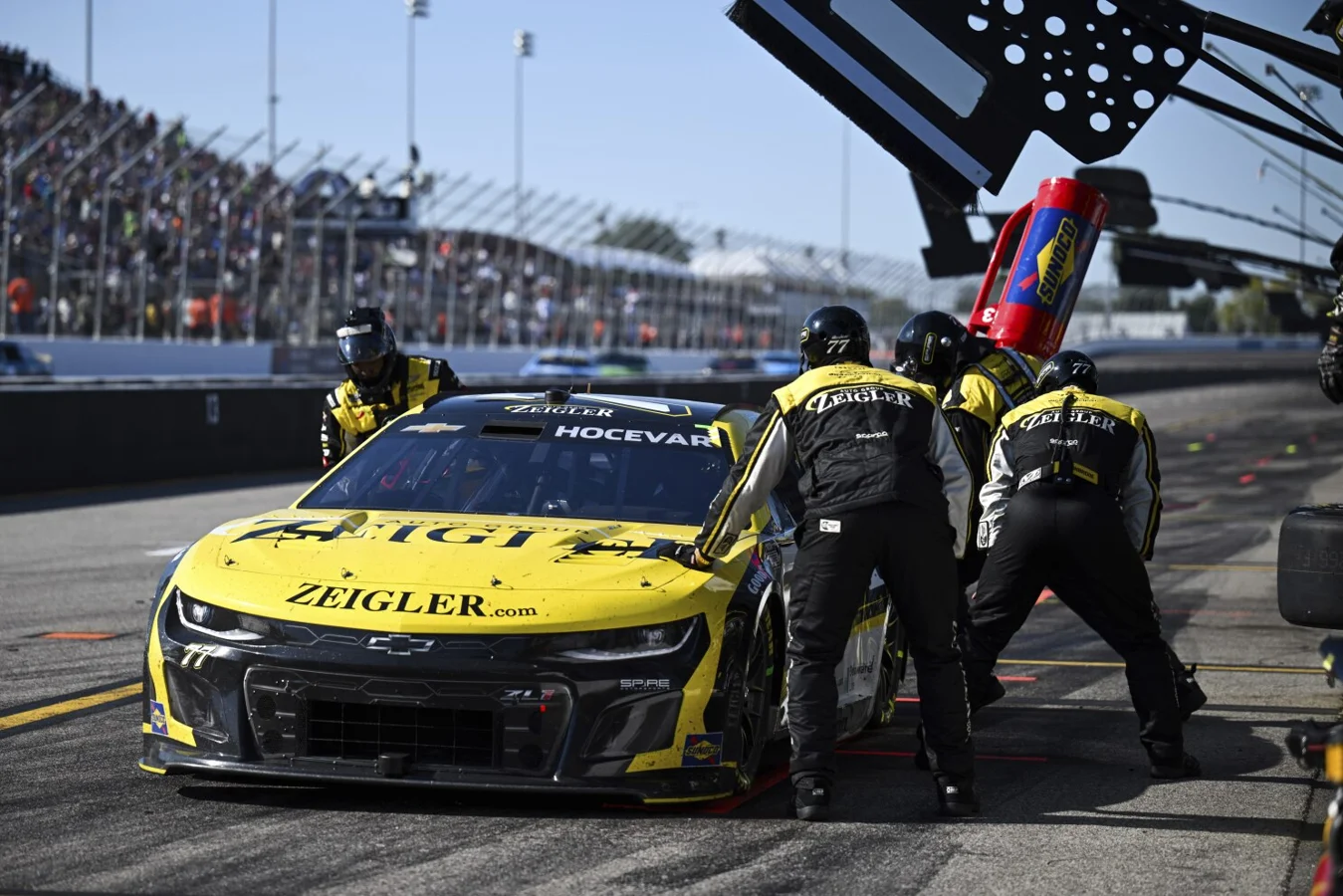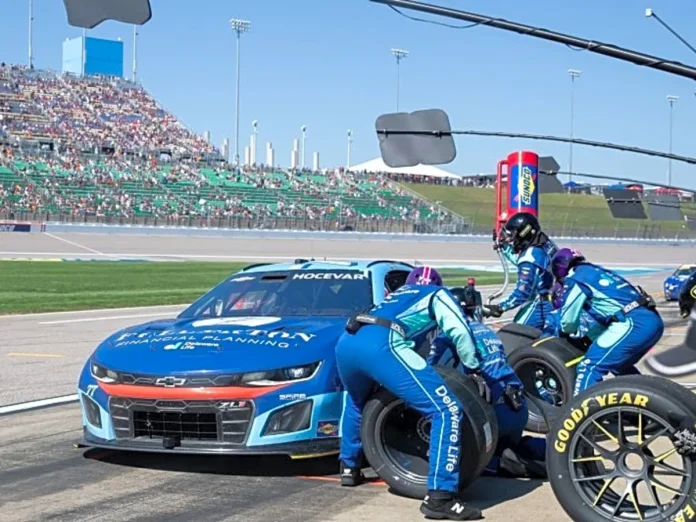Following a dramatic episode involving Carson Hocevar and safety crews at the Brickyard 400 in Indianapolis, NASCAR is considering stricter disciplinary measures for driver conduct and technical violations. The Carson Hocevar NASCAR penalty, which came after his actions endangered track workers, has become a turning point for how the organization views repeat offenses and team behavior.
Carson Hocevar’s Actions Lead to Significant Penalty
During qualifying for the Brickyard 400 at the Indianapolis Motor Speedway, Carson Hocevar spun out on the backstretch and found himself stuck with deflated tires. As safety workers approached his stranded car, Hocevar spun his wheels aggressively in an attempt to get moving again, placing the crew at increased risk. NASCAR responded swiftly by issuing him a $50,000 fine, making it clear that safety infractions are being taken more seriously than ever before.
The Hollywood Casino 400 demonstrated that Hocevar was not alone in facing penalties that week. Multiple teams encountered disciplinary action for various technical violations, further raising concerns about the prevalence and impact of rule-breaking in the series.
Other Teams Face Penalties for Technical Violations
The weekend was marked by a series of infractions beyond Hocevar’s actions. Shane van Gisbergen’s No. 88 Trackhouse Racing Chevrolet, along with Michael McDowell’s car, underwent unapproved front splitter changes after successfully clearing inspection. As a result, both teams saw their crew chiefs ejected from the premises for the duration of the event, lost the ability to choose their pit stalls, and were required to start the race at the back of the field after serving stop-and-go penalties immediately after the green flag.

This crackdown indicates NASCAR’s enhanced vigilance toward maintaining a level playing field among competitors and emphasizing the importance of technical compliance.
NASCAR’s Communication Leaders Address Rising Tensions
Senior representatives from NASCAR’s communications leadership have commented on the spate of penalties and the organization’s shifting approach. Amanda Ellis, NASCAR’s Senior Director of Racing Communications, spoke candidly about the escalation of punishment:
“I think it’s also an element of: we’ve warned them, we will continue to elevate that penalty. In some ways, for some teams, it does appear worth the risk to try and not get caught. Ultimately, though, the more this continues, the more that penalty will 1000% be elevated, probably to a level they won’t enjoy when it happens.”
— Amanda Ellis, Senior Director, Racing Communications, NASCAR
Ellis’s message was clear: persistent offenders will see the consequences intensify, especially as safety and fairness are placed at the forefront of race operations. These remarks have high stakes, with the atmosphere among teams and drivers growing more charged as the playoffs continue.
The organization’s concerns were further echoed by Mike Forde, Managing Director of NASCAR’s Racing Communications, who highlighted how some teams have managed to rebound from penalties, raising questions about the deterrent effect of current enforcement:
“By the way, I should mention—sorry, at another point, I’m reading into Elton’s words—I haven’t talked to him about this, but I thought it was interesting in the SiriusXM interview how he mentioned that the 24 at Daytona and then again the 88 and 71 this weekend were able to rebound from their penalties. In all three instances, they’re keeping track of that, which means… I’m reading between the lines here. I could see Amanda’s point earlier—ramping up penalties. You have to ask yourself, is this enough to deter teams when they’re able to get back?”
— Mike Forde, Managing Director, Racing Communications, NASCAR
These insights from Ellis and Forde reveal internal debates within NASCAR about whether current policies go far enough in discouraging rule-breaking, especially when some teams seem undaunted by fines or procedural setbacks.
Pattern of Leniency and Its Consequences
The penalty process over recent races demonstrates a historical pattern of teams risking technical offenses for on-track gain. Cody Ware’s No. 51 Rick Ware Racing Ford failed inspection twice during the same weekend, clearing only on the third try, which led to the ejection of his car chief Dave Jones and a loss of pit stall selection—a significant disadvantage for the team going into the race.
William Byron’s case at Daytona in August further illustrates the issue. After his No. 24 Hendrick Motorsports Chevrolet failed the Underbody Scanning Station (USS) on a second inspection due to an illicit splitter adjustment, his crew chief was ejected, and Byron lost pit stall privileges before starting from the rear and serving an early stop-and-go penalty. However, Byron managed to recover from these setbacks, avoiding an eleven-car pileup on track, climbing to the lead, and ultimately taking a win at Daytona for a second time in succession.
The ability of skilled drivers and resilient teams to overcome severe penalties has led NASCAR officials to rethink if punishment severity should escalate to create more effective deterrents. The events at Kansas reinforced these concerns, as multiple teams still managed strong finishes or points gains despite starting from difficult positions imposed by disciplinary rulings.
Performance Amidst Adversity Highlights the Stakes
At Kansas, SVG (Shane van Gisbergen) earned his first top-10 finish on a NASCAR Cup Series oval with his No. 88 car, even after being penalized and forced to the back of the grid. Michael McDowell similarly delivered a notable 14th-place result for Spire Motorsports after starting at the rear. Their resilience made clear that teams can mitigate or overcome certain penalties, which, in turn, pressures NASCAR to refine its system to maintain parity and safety in the fiercely competitive environment.
This persistent defiance, displayed by drivers such as Byron, McDowell, and van Gisbergen despite administrative hurdles, underscores why NASCAR officials now stress the need to increase the bite in their penalty structure. The stakes are especially high as the NASCAR Cup playoffs continue and teams seek every advantage.
Setting Expectations Ahead of the Charlotte Roval
As teams prepare for the Bank of America Roval 400 at Charlotte, conversations around stricter enforcement and the recent Carson Hocevar NASCAR penalty loom large. The high-paced, unpredictable Roval circuit offers a fresh test, where technical compliance and on-track discipline will be under the microscope. Despite Chase Elliott’s recent win at Kansas securing his playoff progression, much of the spotlight is on drivers like Shane van Gisbergen, whose performances in road course conditions have marked him as one of the season’s most formidable non-playoff competitors.
Van Gisbergen’s consistent success on road circuits has not gone unnoticed, with sports betting platforms like FanDuel Sportsbook listing him as a favorite for this upcoming race. The odds point to strong momentum favoring SVG, whose adaptability and skill across diverse tracks make him a threat—even as prior penalties highlight the thin margins between victory and setback in this playoff phase.
The interplay of penalty enforcement, team strategies, and driver resilience is expected to shape the dynamics at Charlotte. For fans, teams, and NASCAR leadership, the weekend will serve as another barometer for the balance between competition and regulation.
The Road Ahead for NASCAR and Its Teams
The recent series of fines and disciplinary actions, highlighted by the Carson Hocevar NASCAR penalty, signals a critical juncture for the sport. With key figures like Amanda Ellis and Mike Forde calling for increased penalties, NASCAR is sending a message that future infractions will face even graver consequences. For drivers and teams, the challenge will be to balance innovation and risk with rule compliance, as any misstep can bring not just financial loss but significant competitive disadvantages.
As the Cup Series moves toward the Round of 12 elimination race at Charlotte Roval, all eyes will be on whether stricter measures can preserve safety and fairness without stifling the intense drama that defines NASCAR competition. Recent events suggest that both the organization and its participants are bracing for higher stakes and a new era of enforcement, as fans and officials alike seek to balance tradition with the evolving demands of the modern sport.


